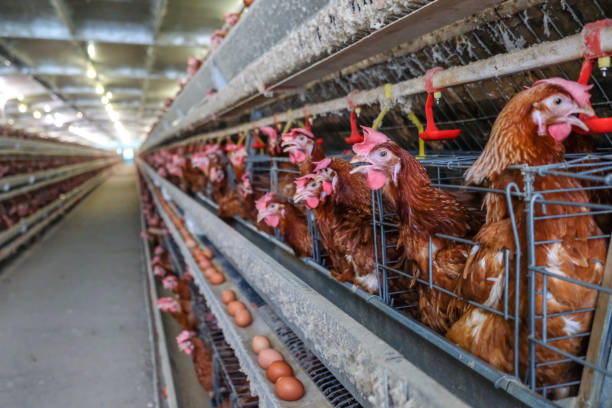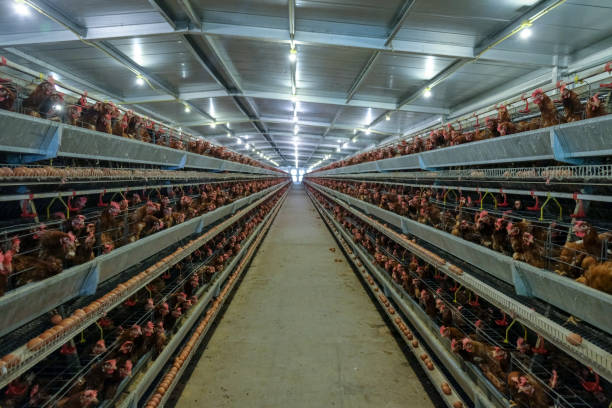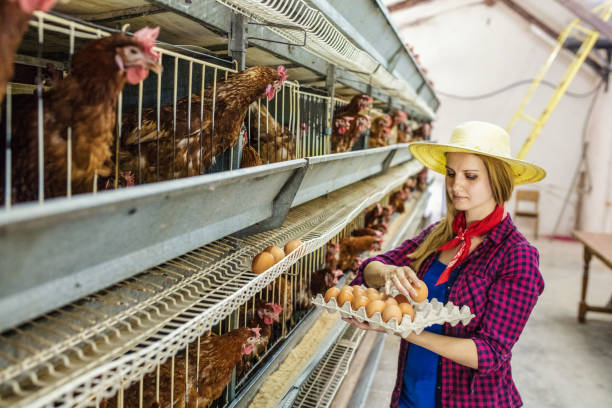Broiler Automation System for 10,000 Chickens: Maximize Efficiency & Profit
Broiler Automation System for 10,000 Chickens: Maximize Efficiency & Profit
Raising broiler chickens on a large scale, like 10,000 birds, presents both considerable opportunities and daunting challenges. Successfully navigating this venture requires more than just basic knowledge; it demands strategic planning, efficient resource management, and a keen understanding of modern poultry farming techniques. One of the most impactful strategies for achieving profitability and operational excellence in such a large-scale operation is the implementation of a comprehensive broiler automation system.
What is a Broiler Automation System?
A broiler automation system is an integrated suite of technologies designed to streamline and optimize various aspects of broiler chicken farming. It moves manual, labor-intensive processes into automated, computer-controlled systems. This includes aspects like feeding, watering, climate control, waste management, and data collection, all working in concert to create an environment that promotes rapid growth, minimizes disease risk, and reduces operational costs.
Why Automate a 10,000-Chicken Broiler Farm?
Scaling up to 10,000 chickens dramatically amplifies the complexities inherent in poultry farming. Manual intervention become increasingly unsustainable and inefficient. Automation addresses these challenges directly, offering several key advantages:
Enhanced Efficiency: Automated feeding systems deliver precise feed amounts at predetermined intervals, minimizing feed waste and ensuring consistent nutrition for all birds. Automated watering systems provide a continuous supply of fresh, clean water, vital for optimal growth and health.
Improved Environmental Control: Maintaining a consistent and optimal environment within the broiler house is crucial for chick survival, growth rate, and feed conversion ratio. Automated climate control systems, including ventilation fans, heaters, and cooling pads, constantly monitor and adjust temperature, humidity, and air quality, minimizing stress on the birds.
Reduced Labor Costs: Manually managing 10,000 chickens across various tasks requires a significant labor force. Automation significantly reduces the need for manual labor, leading to substantial cost savings over time. This allows you to allocate employees to more strategic roles, such as monitoring bird health and analyzing data.
Better Biosecurity: Automated systems reduce the need for human entry into the broiler house, minimizing the risk of disease introduction and spread. This is especially critical in large-scale operations where disease outbreaks can be devastating. Furthermore, automated waste removal systems help maintain a cleaner and healthier environment, further reducing disease risk.
Real-Time Data & Analysis: Modern broiler automation systems incorporate sensors and data loggers that continuously monitor key parameters such as temperature, humidity, feed consumption, water intake, and bird weight. This data is then analyzed using sophisticated software to provide real-time insights into flock performance. This information enables farmers to identify potential problems early, make data-driven decisions, and optimize their management practices for maximum profitability.
Increased Profitability: The combined effect of improved efficiency, reduced labor costs, better environmental control, and data-driven decision-making translates directly into increased profitability. Automation allows you to produce more birds, more efficiently, with lower mortality rates, and improved feed conversion ratios.
Key Components of a Broiler Automation System for 10,000 Chickens
To effectively manage a 10,000-chicken broiler farm, the automation system should encompass the following key components:

Automated Feeding System:
Feed Silos: Large-capacity silos for storing bulk feed, minimizing manual handling and reducing the risk of contamination.
Conveying System: Automated conveying systems, such as augers or chain feeders, to transport feed from the silos to the broiler house.
Feed Distribution System: Distributes feed evenly throughout the house using chain feeders, tube feeders, or pan feeders. The system can be programmed to deliver specific feed amounts at predetermined intervals.
Feed Level Sensors: Sensors that monitor feed levels in the feeders and automatically replenish them as needed, ensuring a continuous supply of feed for the birds.
Automated Watering System:
Water Source & Storage: A reliable water source with adequate storage capacity to meet the needs of 10,000 chickens.
Water Filtration & Treatment: Filtration and treatment systems to ensure the water is clean and free of contaminants.
Nipple Drinkers: Nipple drinkers provide a continuous supply of fresh, clean water while minimizing water wastage and preventing contamination. The height and pressure of the nipple drinkers can be adjusted to suit the age and size of the birds.
Water Metering: Water meters to monitor water consumption and identify potential leaks or problems with the watering system.
Automated Climate Control System:

Ventilation Fans: Exhaust fans and circulation fans to maintain optimal air quality and prevent the buildup of harmful gases such as ammonia. Variable-speed fans can be controlled automatically based on temperature and humidity levels.
Heating System: Gas heaters, radiant heaters, or other heating systems to maintain a comfortable temperature for the birds, especially during colder months.
Cooling System: Evaporative cooling pads, misting systems, or other cooling systems to lower the temperature inside the broiler house during hot weather.
Temperature & Humidity Sensors: Sensors strategically placed throughout the broiler house to continuously monitor temperature and humidity levels.
Control System: A central control system that uses data from the sensors to automatically adjust the ventilation, heating, and cooling systems to maintain optimal environmental conditions.
Automated Waste Management System:
Manure Removal System: Automatic manure removal systems, such as belt systems or scraper systems, to remove manure from the broiler house regularly. This helps maintain a cleaner and healthier environment and reduces the risk of disease.
Manure Storage: A designated area for storing manure before it is disposed of or used as fertilizer.
Odor Control System: Systems to minimize odor emissions from the broiler house, such as biofilters or chemical scrubbers.
Data Monitoring & Control System:
Sensors & Data Loggers: A network of sensors and data loggers to continuously monitor key parameters such as temperature, humidity, feed consumption, water intake, and bird weight.
Central Control Unit: A central control unit that collects data from the sensors and data loggers and displays it in a user-friendly format.
Software & Analytics: Software that analyzes the data to provide real-time insights into flock performance and identify potential problems.
Remote Access: The ability to remotely monitor and control the system via a computer or mobile device.
Alarm System: An alarm system that alerts you to any deviations from the pre-set parameters, such as a sudden drop in temperature or a spike in ammonia levels.
Choosing the Right Automation System
Selecting the right automation system for your 10,000-chicken broiler farm is a critical decision that will significantly impact your profitability and overall success. Consider the following factors when making your selection:
Scalability: Choose a system that can be easily expanded or upgraded as your operation grows.
Durability: Select high-quality, durable equipment that can withstand the harsh environment of a broiler house.
Ease of Use: Opt for a system that is easy to operate and maintain, with a user-friendly interface.
Technical Support: Ensure that the supplier provides comprehensive technical support and training.
Cost: Consider the total cost of ownership, including the initial investment, operating costs, and maintenance costs.
Reputation of Supplier: Research the reputation and experience of the supplier. Look for a company with a proven track record of providing reliable and effective automation solutions.
Installation and Maintenance
Proper installation and regular maintenance are essential for ensuring the long-term performance and reliability of your broiler automation system.
Installation:
Hire a qualified technician to install the system according to the manufacturer’s instructions.
Ensure that the system is properly calibrated and tested before it is put into operation.
Maintenance:
Implement a regular maintenance schedule to inspect and clean all components of the system.
Replace worn or damaged parts promptly.
Keep accurate records of all maintenance activities.
Training:
Provide adequate training to your employees on the operation and maintenance of the system.
Encourage employees to report any problems or concerns promptly.
Return on Investment (ROI)

While the initial investment in a broiler automation system can be significant, the long-term return on investment can be substantial. By improving efficiency, reducing labor costs, and enhancing biosecurity, the system can pay for itself in a relatively short period of time.
Calculating ROI:
To estimate the potential ROI of a broiler automation system, consider the following factors:
Reduced labor costs
Improved feed conversion ratio
Lower mortality rates
Increased bird weight
Reduced energy consumption
Reduced water consumption
Improved biosecurity
By quantifying the potential savings and benefits, you can determine whether a broiler automation system is a worthwhile investment for your 10,000-chicken broiler farm.
Conclusion
A well-designed and implemented broiler automation system is a powerful tool for maximizing efficiency and profitability in a 10,000-chicken broiler farm. By automating key processes such as feeding, watering, climate control, and waste management, you can significantly reduce labor costs, improve bird health, and increase overall productivity. Before investing, be sure to carefully evaluate your needs, research different systems, and choose a reliable supplier with a proven track record. With the right automation system in place, you can create a thriving and profitable broiler farming operation. The key is to envision not just the cost now, but the long-term benefits that a strategically implemented automation system can provide for years to come. That investment, done wisely, will repay itself in efficiency, profitability, and peace of mind.





